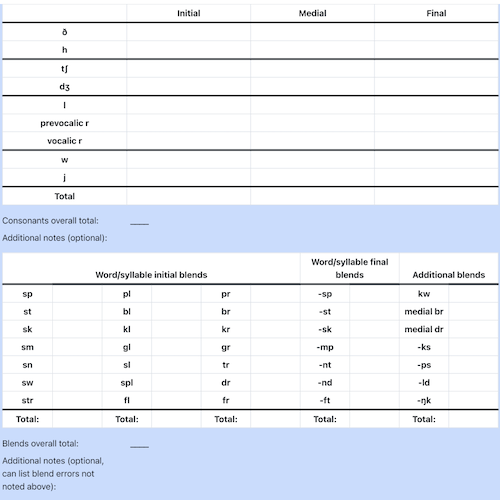Sidekick Speech Sound Error Analysis Assessment

Description
Sidekick Therapy Partners' Speech Sound Error Analysis Assessment was created as a complementary assessment tool to be used in conjunction with formal standardized speech measures/test protocols, and speech samples. It includes charts to write out errors observed in sounds and commonly observed blends at the word and sentence level. The assessment tool also includes a summary section for scores obtained from a standardized assessment protocol, a section for intelligibility, and a section for stimulability observations.
This tool is licensed for non-commercial use only. You may adapt it with proper attribution to the creators (Ian Quillen & Rob Vitaro) as long as you use the same licensing restrictions on your adapted work.
This tool is licensed for non-commercial use only. You may adapt it with proper attribution to the creators (Ian Quillen & Rob Vitaro) as long as you use the same licensing restrictions on your adapted work.
Strategies and techniques
Use this assessment tool after administering a formal speech sound measure & filling out the protocol, or after collecting a speech sample, to analyze the errors you observe. Sounds are organized by manner of articulation to assist in quickly identifying phonological process error patterns. Use the totals boxes to tally up errors observed. There are sections below each chart to note total errors and additional observations.
License
Additional information
Resource details

Description
Sidekick Therapy Partners' Speech Sound Error Analysis Assessment was created as a complementary assessment tool to be used in conjunction with formal standardized speech measures/test protocols, and speech samples. It includes charts to write out errors observed in sounds and commonly observed blends at the word and sentence level. The assessment tool also includes a summary section for scores obtained from a standardized assessment protocol, a section for intelligibility, and a section for stimulability observations.
This tool is licensed for non-commercial use only. You may adapt it with proper attribution to the creators (Ian Quillen & Rob Vitaro) as long as you use the same licensing restrictions on your adapted work.
This tool is licensed for non-commercial use only. You may adapt it with proper attribution to the creators (Ian Quillen & Rob Vitaro) as long as you use the same licensing restrictions on your adapted work.
Strategies and techniques
Use this assessment tool after administering a formal speech sound measure & filling out the protocol, or after collecting a speech sample, to analyze the errors you observe. Sounds are organized by manner of articulation to assist in quickly identifying phonological process error patterns. Use the totals boxes to tally up errors observed. There are sections below each chart to note total errors and additional observations.
License
Focus areas
- ST -> Articulation -> Substitutions
- ST -> Articulation -> Distortions
- ST -> Articulation -> Omissions
- ST -> Articulation -> Additions
- ST -> Phonology -> Assimilation
- ST -> Phonology -> Cluster Reduction
- ST -> Phonology -> Deaffrication
- ST -> Phonology -> Final Consonant Deletion
- ST -> Phonology -> Fronting
- ST -> Phonology -> Gliding
- ST -> Phonology -> Stopping
- ST -> Phonology -> Vowelization
- ST -> Phonology -> Weak Syllable Deletion
8 more focus areas. Click arrow to view all.
Evidence based practice citations
-
Speech Sound Errors. The Most Common Speech Errors a Child is Likely to Make.
Author(s): David Newmonic -
Speech Sound Disorders: Articulation and Phonology
Author(s): The American Speech-Language-Hearing Association
Grade levels
None
Themes
None
Weekly Themes
None
Daily Themes
None
Blends
None
Phonemes
None
Resource slides
Create a free Ambiki account to preview the slides of this PDF resource.
